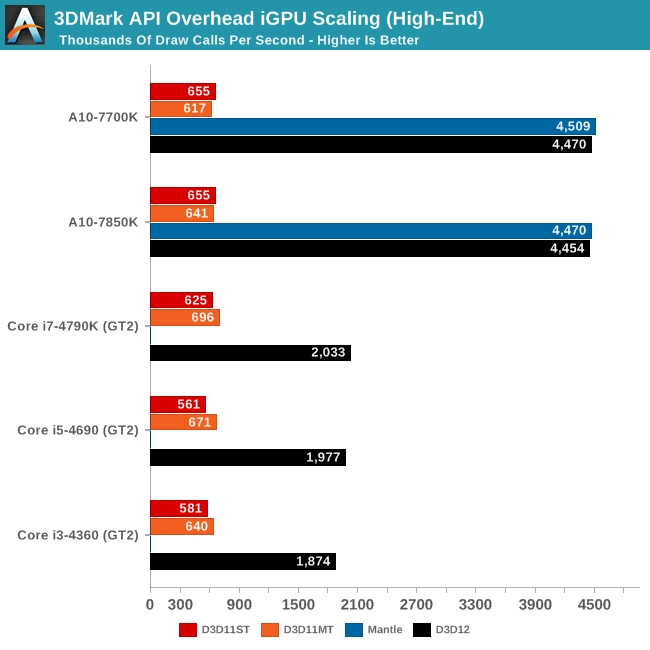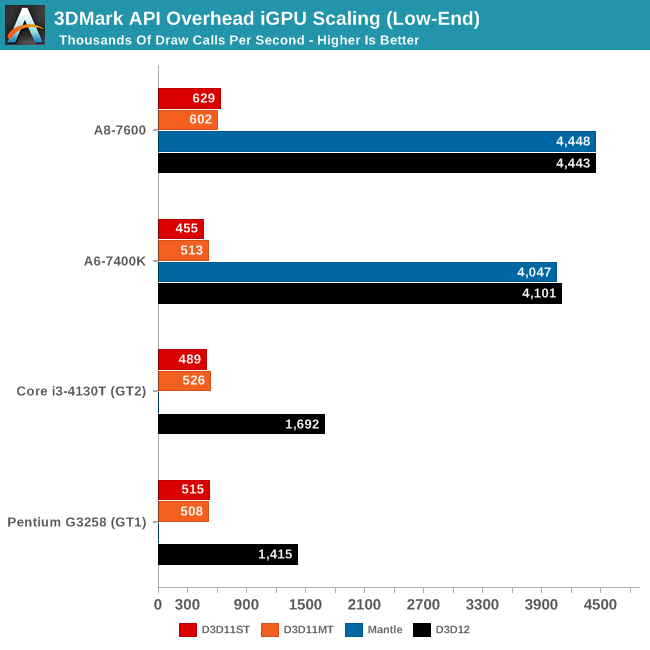Exploring DirectX 12: 3DMark API Overhead Feature Test
by Ryan Smith & Ian Cutress on March 27, 2015 8:00 AM EST- Posted in
- GPUs
- Radeon
- Futuremark
- GeForce
- 3DMark
- DirectX 12
Integrated GPU Testing
Switching gears from high performance discrete GPUs, we have our integrated GPUs. From a high level overview the gains from DirectX 12 are not going to be quite as large here as they are with dGPUs due to the much lower GPU performance, but there is still ample opportunity benefit from increased draw call performance.
Here we have Intel’s Haswell CPUs, and AMD’s Kaveri APUs. We'll start off with the higher-end processors, the Intel Core i3/i5i7 and AMD A10/A8.

As expected, at the high-end the performance gains from DirectX 12 are not quite as great as they were with the dGPUs, but we’re still seeing significant gains. The largest gains of course are found with the AMD processors, thanks to their much stronger iGPUs. From DX11ST to DX12 we’re seeing a surprisingly large 6.8x increase in draw call performance, from 655K to 4,470K.
As to be expected, with a relatively weak CPU, AMD’s DX11 draw call performance isn’t very strong here relative to their strong GPU and of course our more powerful dGPUs. Still, it ends up being better than Intel (who otherwise has the stronger CPU), so we see AMD offering better draw call throughput at all levels. Ultimately what this amounts to is that AMD has quite a bit more potential under DX12.
Mantle meanwhile delivers a very slight edge over DX12 here, although for all practical purposes the two should be considered tied.
Meanwhile for the Intel CPUs, the gains from DX12 aren’t quite as large as with the AMD processors, but they’re still significant, and this is why Intel is happily backing DX12. All 3 processors share the same GT2 GPU and see similar gains. Starting from a baseline of 625K draw calls under DX11 – almost identical to AMD – the i7-4790K jumps up by 3.2x to 2,033K draw calls under DX12. The i5 and the i3 processors see 1,977K and 1,874K respectively, and after adjusting for clockspeeds it’s clear that we’re GPU command processor limited at all times here, hence why even a 2 core i3 can deliver similar gains.
Intel does end up seeing the smallest gains here, but again even in this sort of worst case scenario of a powerful CPU paired with a weak CPU, DX12 still improved draw call performance by over 3.2x. This means that in the long run even games that are targeting lower-performance PCs still stand to see a major increase in the number of draw calls they can use thanks to DirectX 12.

The story is much the same with our lower performance processors. AMD continues to see the largest gains and largest absolute performance under DirectX 12. With a 7x performance increase for the A8, even this weaker processor benefits greatly from the use of a low-level API.
The Intel processors see smaller gains as well, but they too are similarly significant. Even the Pentium with its basic GT1 processor and pair of relatively low clocked CPU sees a 2.7x increase in draw call performance from DirectX 12.










113 Comments
View All Comments
akamateau - Thursday, April 30, 2015 - link
DX12 renders expensive Intel silicon useless when benched against AMD APU or FX feeding Radeon.If you are happy with you gameplay running a $1500 Intel/nVidia with DX11 gaming rig then you will be ecstatic with just a $150 A10 APU running DX12.
kyllients - Friday, June 26, 2015 - link
You seem to be confused. High end silicon like the NVidia 980 Ti with DX12 is going to run circles around any integrated graphics.Erebus5683 - Wednesday, May 6, 2015 - link
Anand says in the article that GCN 1.0 is now working. And they text a HD7970 to prove it. I have a 7950, latest drivers and Win10, and it says "API not supported". Can Anand or anyone here explain why this might be?